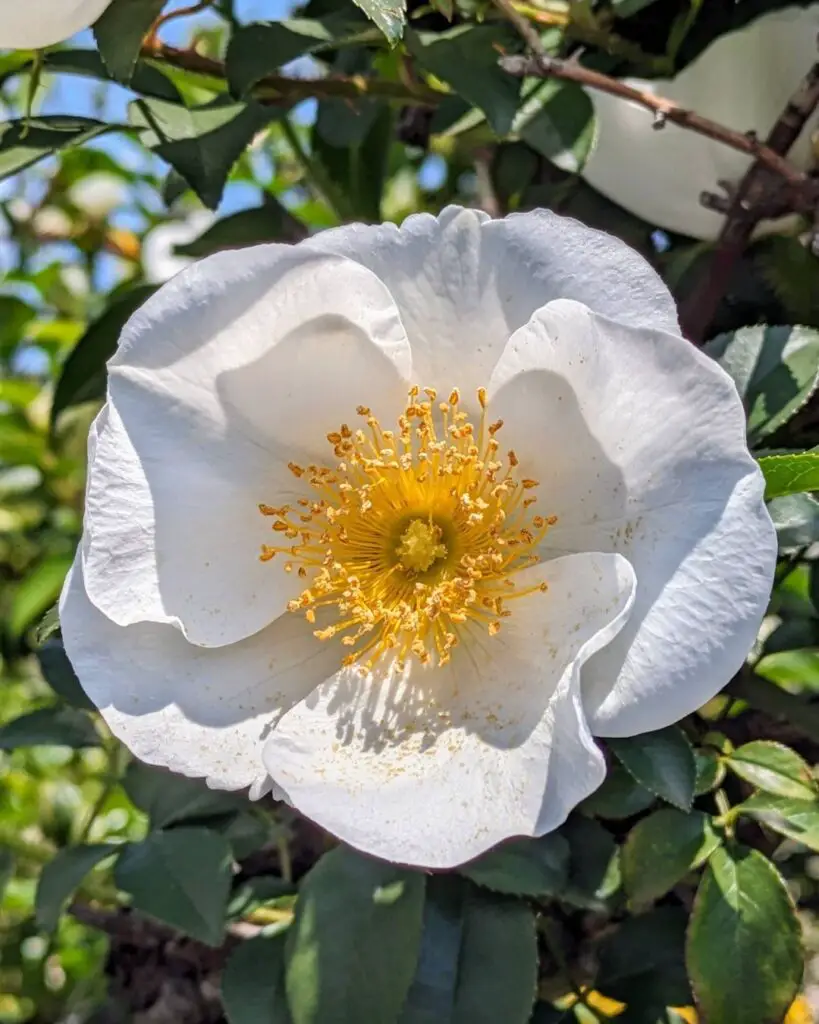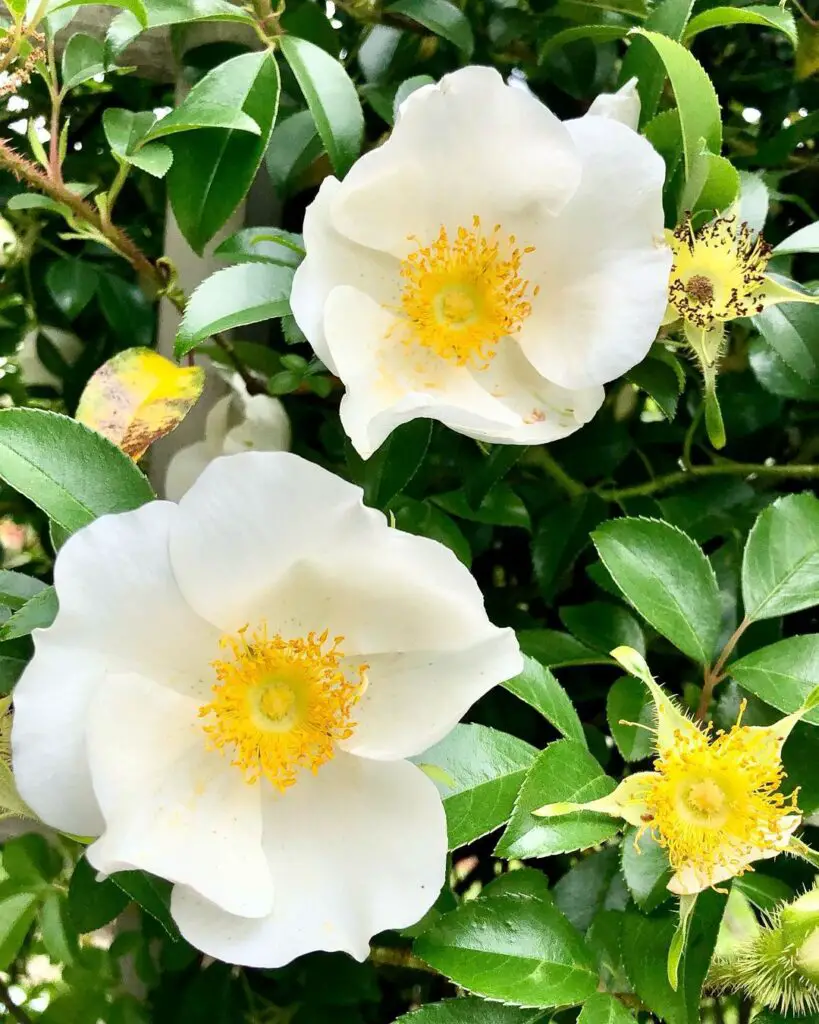Cherokee Rose: Legend and Beauty
In the heart of Southern lore and amidst the verdant landscapes of the American South, the Cherokee Rose stands as a poignant symbol of resilience and natural elegance. Named for the Cherokee people, who cherished its delicate blooms, this graceful flower weaves a tale of myth and history that captivates both botanists and romantics alike.
Legend whispers that the Cherokee Rose sprang from the tears of mothers mourning the Trail of Tears—a testament to the sorrow and strength of a people uprooted but never defeated. Beyond its mythical origins, the Cherokee Rose enchants with its simple yet striking white petals and golden center, evoking a sense of purity and hope amidst adversity.
Join us as we delve into the rich tapestry of folklore surrounding the Cherokee Rose, exploring its botanical wonders and cultural significance. Discover how this resilient bloom continues to bloom not only in gardens but also in the hearts of those who cherish its enduring beauty.

What Is Cherokee Rose and Should You Grow It or Not?
We’ll discuss the topic step by step. So, bear with us, and let’s dive into it:
What is a Cherokee Rose?
The Cherokee Rose (Rosa laevigata) is a species of rose native to China, Taiwan, Laos, and Vietnam, and naturalized in parts of the southeastern United States. It is renowned for its vigorous growth, climbing abilities, and resilience in various climates. This rose species typically features white flowers with a yellow center, blooming profusely in spring and intermittently throughout the year in favorable conditions.
In the United States, the Cherokee Rose holds cultural significance, especially among Native American communities, particularly the Cherokee people, who value it as a symbol of beauty and endurance. Historically, it became associated with the Trail of Tears, symbolizing the sorrow and strength of the Cherokee Nation during their forced relocation in the 19th century.
Today, the Cherokee Rose continues to thrive both in its native habitats and in gardens worldwide, admired not only for its aesthetic appeal but also for its adaptability and historical resonance.
The Origin of Cherokee Rose
The Cherokee Rose (Rosa laevigata) holds a poignant origin story deeply rooted in Native American folklore. Legend tells that during the Trail of Tears in the 1830s, Cherokee mothers shed tears of sorrow for their lost children. Where these tears fell, it’s said that the Cherokee Rose grew, symbolizing their resilience and hope amidst tragedy.
Botanically, the Cherokee Rose is native to southeastern China and has been naturalized in the southeastern United States. It thrives in sunny, well-drained soil, producing fragrant white blooms with golden stamens. This rose variety not only beautifies landscapes but also serves as a living tribute to the enduring spirit of the Cherokee people.

The History of Cherokee Rose
The Cherokee Rose (Rosa laevigata) holds a significant place in both botanical and cultural history. Believed to have originated in East Asia, particularly in China, it made its way to North America where it became deeply intertwined with the Cherokee people. The rose’s migration to the United States likely occurred around the late 18th or early 19th century, marking its introduction into Southern landscapes.
Named to honor the Cherokee nation, the rose symbolizes their resilience and survival, particularly during the forced relocation known as the Trail of Tears in the 1830s. Legend has it that the tears shed by Cherokee mothers during this tragic journey transformed into these beautiful white blooms, forever linking the rose to a poignant tale of loss and endurance.
Today, the Cherokee Rose continues to thrive in gardens across the Southern United States, celebrated not only for its history but also for its delicate beauty and enduring cultural significance.
Origin State of Cherokee Rose
The Cherokee Rose (Rosa laevigata) is native to East Asia, specifically originating from China, Taiwan, and possibly Vietnam. Introduced to the United States in the late 18th century, it quickly naturalized in the southeastern states, particularly in Georgia. This region now proudly claims it as its state flower, honoring its cultural and historical significance.
The Cherokee Rose thrives in diverse habitats, from woodlands to open fields, where its vigorous growth and prolific white blossoms with golden centers have earned it admiration and cultivation across the Southern landscape. Today, it remains a symbol of beauty and resilience deeply rooted in Southern heritage.
What Is the Symbolic Meaning of Cherokee Rose?
The Cherokee Rose symbolizes resilience and hope, deeply rooted in the history and culture of the Cherokee people. Legend has it that the rose bloomed along the Trail of Tears, where Cherokee mothers shed tears of grief. Its pure white petals symbolize purity, peace, and the strength to endure hardship.
The golden center represents the bright future and hope for a better tomorrow. Beyond its cultural significance, the Cherokee Rose embodies the spirit of survival and adaptation, thriving in diverse landscapes and climates, a testament to the enduring legacy of resilience in the face of adversity.

Facts about the Cherokee Rose
The Cherokee Rose (Rosa laevigata) is a species native to Southeastern United States and East Asia, known for its distinct characteristics and cultural significance:
Native Habitat and Distribution
- Originally native to the southeastern United States, particularly Georgia and South Carolina.
- Also found in parts of East Asia, including China and Taiwan.
Physical Characteristics
- Features large, solitary white flowers with golden stamens, often reaching up to 4 inches (10 cm) in diameter.
- Glossy, dark green leaves that remain evergreen in warmer climates.
Cultural Symbolism
- Adopted as the state flower of Georgia in 1916, symbolizing resilience and beauty.
- In Cherokee legend, the rose symbolizes the Trail of Tears, where the mothers’ tears for their lost children are said to have turned into Cherokee Roses along the trail.
Ecological Role
- Provides food and shelter for various wildlife, including birds and insects.
- Can grow vigorously and forms dense thickets along roadsides and in disturbed habitats.
Conservation Status
- Considered a species of least concern globally, but local populations may face threats from habitat loss and invasive species.
Uses
- Ornamental plant in gardens and landscapes, prized for its ornate flowers and evergreen foliage.
- Occasionally used in traditional medicine for its purported medicinal properties.
These facts encapsulate the essence of the Cherokee Rose, highlighting its natural beauty, cultural significance, and ecological importance.
Planting Cherokee Rose
Planting the Cherokee Rose requires careful consideration of location, soil preparation, and planting technique to ensure optimal growth and blooming:

Choosing the Right Location:
- Select a sunny spot that receives at least 6 hours of direct sunlight daily.
- Ensure the area has well-drained soil to prevent waterlogging, as Cherokee Roses prefer moist but not waterlogged conditions.
Soil Preparation:
- Prepare the soil by loosening it to a depth of about 12 inches.
- Incorporate organic matter such as compost or well-rotted manure to improve soil structure and fertility.
Planting Technique:
- Dig a hole twice as wide and deep as the root ball of the Cherokee Rose plant.
- Gently remove the plant from its container or packaging, being careful not to damage the roots.
- Place the plant in the center of the hole, ensuring the top of the root ball is level with the surrounding soil.
- Backfill the hole with soil and gently firm it around the base of the plant to remove air pockets.
- Water thoroughly after planting to settle the soil and help establish the roots.
Maintenance:
- Mulch around the base of the plant to conserve moisture and suppress weeds.
- Water regularly, especially during dry spells, to keep the soil evenly moist but not waterlogged.
- Prune lightly after flowering to maintain shape and encourage new growth.
By following these steps, you can successfully plant and care for Cherokee Roses, ensuring they thrive and bloom beautifully in your garden.
How to Grow Cherokee Rose in Your Garden
Choosing the Right Location
Select a sunny spot with well-draining soil for optimal growth. Cherokee Roses thrive in full sunlight, though they can tolerate partial shade.
Planting
- Prepare the Soil: Ensure the soil is fertile, well-drained, and slightly acidic (pH 6.0-6.5).
- Spacing: Plant Cherokee Roses 3-4 feet apart to allow for adequate air circulation.
- Planting Depth: Dig a hole twice as wide and deep as the root ball. Place the plant so the crown (where the roots meet the stems) is at ground level.
Watering and Maintenance
- Watering: Water deeply once or twice a week, especially during dry spells, to establish roots.
- Mulching: Apply a layer of organic mulch around the base to retain moisture and suppress weeds.
- Fertilizing: Feed with a balanced fertilizer in early spring to promote healthy growth and flowering.
Pruning
- Timing: Prune lightly after flowering to shape and remove dead or weak branches.
- Deadheading: Remove spent flowers to encourage continuous blooming.
Protection from Pests and Diseases
- Monitoring: Regularly inspect for pests like aphids and diseases such as powdery mildew.
- Treatment: Use organic insecticides or fungicides as necessary, following manufacturer instructions.
By following these simple steps, you can successfully cultivate the beauty and resilience of the Cherokee Rose in your own garden.
Care Tips for Cherokee Rose
1. Planting Location:
Choose a sunny location with well-drained soil for optimal growth.
- Ensure the area receives at least 6 hours of sunlight daily.
- Amend soil with organic matter to improve drainage and nutrient content.
2. Watering Requirements:
Provide regular watering, especially during dry spells, to establish roots and promote flowering.
- Water deeply once a week, ensuring the soil is moist but not waterlogged.
- Reduce watering in winter to prevent root rot.
3. Pruning and Maintenance:
Prune Cherokee Roses in late winter or early spring to promote new growth and maintain shape.
- Remove dead or diseased branches to encourage healthy growth.
- Cut back old canes to ground level to rejuvenate the plant.
4. Fertilizing Schedule:
Feed with a balanced fertilizer in early spring and again after the first bloom.
- Use a fertilizer with equal parts nitrogen, phosphorus, and potassium to support overall health and flower production.
- Avoid over-fertilizing, which can lead to excessive foliage growth at the expense of blooms.
5. Pest and Disease Control:
Monitor for common pests like aphids and spider mites, especially during warm weather.
- Use insecticidal soap or neem oil for organic pest control.
- Prevent fungal diseases by spacing plants for good air circulation and avoiding overhead watering.
6. Winter Protection:
Protect young plants from frost with mulch or row covers during the winter months.
- Mulch around the base of the plant to insulate roots and conserve moisture.
- Prune back long canes to prevent wind damage and maintain plant structure.
By following these care tips, you can ensure your Cherokee Rose thrives, offering beautiful blooms and enduring charm year after year.
Frequently Asked Questions
What is the significance of the Cherokee Rose in Southern folklore?
The Cherokee Rose holds deep cultural significance in Southern folklore, believed to have bloomed from the tears of Cherokee mothers during the Trail of Tears. Its white petals with a golden center symbolize purity and hope, honoring the resilience of the Cherokee people.
How does the Cherokee Rose thrive in different climates?
Cherokee Roses are hardy and adaptable, thriving in a variety of climates from the warm, humid regions of the Southern United States to cooler climates with adequate sunlight and well-drained soil. They require moderate watering and benefit from pruning to maintain their shape and health.
What are some common uses of the Cherokee Rose in landscaping?
In landscaping, Cherokee Roses are prized for their climbing ability and ornamental beauty. They are often used to cover fences, trellises, and arbors, providing a stunning display of white flowers with a delicate fragrance. Their resilience and easy maintenance make them popular choices for both residential and public gardens.
How can I care for a Cherokee Rose in my garden?
To care for a Cherokee Rose, plant it in well-drained soil enriched with organic matter and place it in a sunny location. Water regularly, especially during dry spells, and prune lightly after flowering to encourage new growth and maintain a tidy appearance. With proper care, your Cherokee Rose will thrive and reward you with its graceful blooms year after year.
Conclusion
In conclusion, the Cherokee Rose stands not only as a botanical marvel but also as a poignant symbol of resilience and cultural heritage. From its origins in Southern folklore to its adaptability in diverse climates, this graceful flower continues to enchant with its simple yet profound beauty. Whether adorning gardens, climbing trellises, or weaving tales of hope, the Cherokee Rose remains a timeless emblem of strength and natural elegance. Embrace its legacy, nurture its growth, and let its blossoms remind us of the enduring spirit that blooms even in the face of adversity.

I’m Shofi, a passionate gardener and blogger. I have 10+ years of experience in gardening and hold certifications in horticulture and garden design. I share my knowledge and skills through my garden blog to inspire and educate others on the joys of gardening. I try to provide valuable information and create a community for gardeners of all levels to connect and learn. My ultimate goal is to inspire others to start their own gardens and connect with nature.

